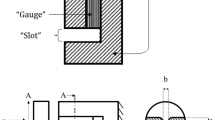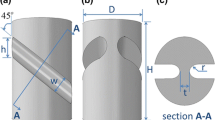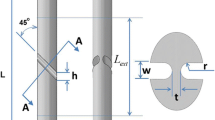Abstract
The shear compression specimen (SCS), which is used for large strain testing, is thoroughly investigated numerically using three-dimensional elastoplastic finite element simulations. In this first part of the study we address quasi-static loading. A bi-linear material model is assumed. We investigate the effect of geometrical parameters, such as gage height and root radius, on the stress and strain distribution and concentration. The analyses show that the stresses and strains are reasonably uniform on a typical gage mid-section, and their average values reflect accurately the prescribed material model. We derive accurate correlations between the averaged von Mises stress and strain and the applied experimental load and displacement. These relations depend on the specimen geometry and the material properties. Numerical results are compared to experimental data, and an excellent agreement is observed. This study confirms the potential of the SCS for large strain testing of material.
Similar content being viewed by others
References
Green, D.E., Neale, K.W., MacEwen, S.R., Makinde, A., andPerrin, R., “Experimental Investigation of the Biaxial Behavior of an Aluminum Sheet,”International Journal of Plasticity,20 (8–9),1677–1706 (2004).
Arcan, M., Hashin, Z., andVoloshin, A.S., “A Method to Produce Uniform Plane-Stress States with Applications to Fiber-reinforced Materials,” EXPERIMENTAL MECHANICS,18 (4),141–146 (1978).
Khan, A.S. andWang, X., “An Experimental Study of Finite Plastic Deformation in Annealed 1100 Aluminum During Proportional and Nonproportional Biaxial Compression,”International Journal of Plasticity,6 (4),485–504 (1990).
Wang, X.F. andLee, L.H.N., “Post-bifurcation Behavior of Wrinkles in square Metal Sheets under Yoshida Test,”International Journal of Plasticity,9, (1),1–19 (1993).
Nouailhas, D. andCailletaud, G., “Tension-torsion Behavior of Single-crystal Superalloys—Experiment and Finite-element Analysis,”International Journal of Plasticity,11, (4),451–470 (1995).
Roessig, K.M. andMason, J.J., “Adiabatic Shear Localization in the Dynamic Punch Test. Part II: Numerical Simulations,”International Journal of Plasticity,15 (3),263–283 (1999).
Rittel, D., Ravichandran, G. andLee, S. “A Shear Compression Specimen for Large Strain Testing,”EXPERIMENTAL MECHANICS,42 (1),58–64 (2002).
Rittel, D., Ravichandran, G., andLee, S., “Large Strain Constitutive Behavior of OFHC Copper over a Wide Range of Strain Rates Using the Shear Compression Specimen,”Mechanics of Materials,34 (10),627–642 (2002).
Vural, M., Rittel, D., andRavichandran, G., “Large Strain Mechanical Behavior of 1018 Cold Rolled Steel over a Wide Range of Strain Rates,”Metallurgical and Material Transactions A,34A (12),2873–2885 (2003).
Author information
Authors and Affiliations
Rights and permissions
About this article
Cite this article
Dorogoy, A., Rittel, D. Numerical validation of the shear compression specimen. Part I: Quasi-static large strain testing. Experimental Mechanics 45, 167–177 (2005). https://doi.org/10.1007/BF02428190
Received:
Revised:
Issue Date:
DOI: https://doi.org/10.1007/BF02428190




